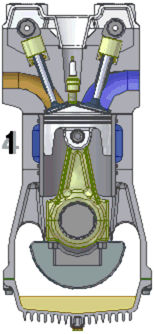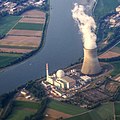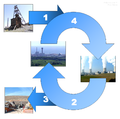Portal:Energy
| Main page | New articles & Tasks |
 The Energy Portal Welcome to Wikipedia's Energy portal, your gateway to energy. This portal is aimed at giving you access to all energy related topics in all of its forms.
|
Page contents: Selected article • Selected image • Selected biography • Did you know? • General images • Quotations • Related portals • Wikiprojects • Major topics • Categories • Help • Associated Wikimedia |
Introduction
Energy (from Ancient Greek ἐνέργεια (enérgeia) 'activity') is the quantitative property that is transferred to a body or to a physical system, recognizable in the performance of work and in the form of heat and light. Energy is a conserved quantity—the law of conservation of energy states that energy can be converted in form, but not created or destroyed; matter and energy may also be converted to one another. The unit of measurement for energy in the International System of Units (SI) is the joule (J).
Forms of energy include the kinetic energy of a moving object, the potential energy stored by an object (for instance due to its position in a field), the elastic energy stored in a solid object, chemical energy associated with chemical reactions, the radiant energy carried by electromagnetic radiation, the internal energy contained within a thermodynamic system, and rest energy associated with an object's rest mass.
All living organisms constantly take in and release energy. The Earth's climate and ecosystems processes are driven primarily by radiant energy from the sun. The energy industry provides the energy required for human civilization to function, which it obtains from energy resources such as fossil fuels, nuclear fuel, and renewable energy. (Full article...)
Selected article
The defining feature of an internal combustion engine is that useful work is performed by the expanding hot gases acting directly to cause movement, for example by acting on pistons, rotors, or even by pressing on and moving the entire engine itself.
Internal combustion engines are most commonly used for mobile propulsion systems, where their high power-to-weight ratios, together with excellent fuel energy-density, are advantageous. They have appeared in almost all automobiles, motorbikes, many boats, and in a wide variety of aircraft and locomotives. Where very high power is required, such as jet aircraft, helicopters and large ships, they appear mostly in the form of gas turbines. They are also used for electric generators and by industry.
The most common fuels in use today are hydrocarbons derived from petroleum including diesel, gasoline and liquified petroleum gas. Most internal combustion engines designed for gasoline can run on natural gas or liquified petroleum gases without modifications except for the fuel delivery components. Liquid and gaseous biofuels, including ethanol and biodiesel can also be used, and trials of hydrogen fuel have been in progress for some years.
Selected image

Photo credit: Andreas Tille
Geysers erupt periodically due to surface water being heated by geothermal heat.
Did you know?

- If atmospheric greenhouse gas concentrations can be stabilized at 450 ppm, it is thought that there will be a 50% chance of avoiding dangerous climate change?
- The Itaipu hydroelectric power plant is currently the second largest power plant in the world, supplying over 90% of Paraguay's electricity, and 25% of Brazil's?
- Libya's Sirte Basin—which in some places lies more than 47 metres below sea level—contains roughly 80% of the country's known crude oil reserves?
- Approximately 95% of the electricity consumed by a normal incandescent light bulb (example pictured) is emitted as heat, rather than as visible light?
- Saudi Aramco is the largest oil corporation in the world and the world's largest in terms of proven crude oil reserves and production?
- Newcastle, Australia, is the world's largest coal export port?
- Surplus income from oil production in Norway is invested by the Government Pension Fund, one of the World's largest funds with a value of around US$ 800 billion?
- Energy superpowers Russia and Venezuela have, respectively, the world's largest reserves of natural gas and petroleum?
Selected biography
In recognition of Watt's achievements, the SI unit of power, the watt, is named after him.
James Watt was born on 19th of January, 1736 in Greenock, a seaport on the Firth of Clyde. His father was a shipwright, shipowner and contractor, while his mother, Agnes Muirhead, came from a distinguished family and was well-educated. Both were Presbyterians and strong Covenanters. Watt attended school irregularly and instead was mostly schooled at home by his mother.
After studying instrument-making for a year in London, the University of Glasgow offered him the opportunity to set up a small workshop within the university. It was established in 1757. After four years, Watt began to experiment with steam, finally producing a working model steam engine in 1765. Strapped for resources to develop a full-scale engine, Watt was forced to take up employment as a surveyor for eight years. Finally, in 1776, the first engines were installed and working in commercial enterprises.
After further improvements, Watt and foundry owner Matthew Boulton established Boulton and Watt in 1794 to exclusively manufacture steam engines. By 1824 it had produced 1,164 steam engines having a total nominal horsepower of about 26,000.
In the news
- 22 November 2024 –
- Energy company Phillips 66 is indicted in United States federal court on six charges of violating the Clean Water Act in Los Angeles County, California, United States. (CBS News)
- 20 November 2024 –
- Indian billionaire and Adani Group chairman Gautam Adani is indicted in the U.S. for his role in an alleged multi-billion dollar bribery and fraud scheme where he and seven others paid Indian government officials US$265 million to obtain contracts for Adani Green Energy. (AsiaOne) (Bloomberg)
- 18 November 2024 – Russian invasion of Ukraine
- Ukrainian energy crisis, 17 November 2024 Russian strikes on Ukraine
- Ukraine re-implements nationwide rolling blackouts primarily due to yesterday's destruction of energy infrastructure by Russian airstrikes. (Reuters)
- 17 November 2024 – Russian invasion of Ukraine
- Russian strikes against Ukrainian infrastructure, Ukrainian energy crisis
General images
Quotations
- "Our children will enjoy in their homes electrical energy too cheap to meter." – Lewis Lichtenstein Strauss, 1954
- "There is every possibility that you will soon be able to tax it." – Michael Faraday, talking to William Gladstone on the future purpose of electricity.
- "Higher energy prices act like a tax. They reduce the disposable income people have available for other things after they've paid their energy bills." – John W. Snow, 2005
- "Our dependence on foreign energy is like a foreign tax on the American people." – George W. Bush, 2005
Related portals
WikiProjects
WikiProjects connected with energy:
Other WikiProjects that may be of interest:
Major topics
Major categories
National energy supply, use & conservation
National electricity sector
Politics, economics, environment
- Climate change
- Energy conservation
- Energy economics
- Energy crises
- Energy development
- Energy policy
- Peak oil
Energy sources
- Fuels
- Biofuels
- Fossil fuels
- Fusion power
- Nuclear technology
- Renewable energy
- Energy conversion
- Electric power
- Energy storage
Energy-related design
Scientific usage
Help

Puzzled by energy?
Can't answer your question?
Don't understand the answer?
- Ask at the reference desk
- Read the Wikipedia help pages
For further ideas, to leave a comment, or to learn how you can help improve and update this portal, see the talk page.
Associated Wikimedia
The following Wikimedia Foundation sister projects provide more on this subject:
-
Commons
Free media repository -
Wikibooks
Free textbooks and manuals -
Wikidata
Free knowledge base -
Wikinews
Free-content news -
Wikiquote
Collection of quotations -
Wikisource
Free-content library -
Wikiversity
Free learning tools -
Wiktionary
Dictionary and thesaurus


























































































































































































